For a SaaS business, acquiring customers can be incredibly difficult. There are many different channels to experiment with, and measuring the effectiveness of each can be challenging.
Search engine optimization (SEO) is one proven customer acquisition strategy for SaaS companies — whether you’re building a small B2B SaaS startup, building an enterprise motion, or even selling SaaS directly to consumers. In a recent survey, Organic Growth Marketing found that in 2023, Google Search was the number-one source of information for B2B buyers who were beginning a buying journey, with 80% of respondents saying that they were satisfied or very satisfied with Google’s organic search results.
Creating an SEO channel does take time and typically takes quite a bit of upfront work. But when built correctly, an SEO channel will become a very high-margin channel and a recurring source of new traffic to your website.
In this article, we’ll highlight the step-by-step process for both starting and scaling an SEO channel for a SaaS business. We’ll also provide three real-life examples of SaaS SEO strategies being used today, with a breakdown of best practices that you can implement on your website.
6 Steps to Building a Fantastic SEO Channel for SaaS Companies
People, especially the ones at SEO agencies, make building an SEO channel seem more complicated than it truly is. For most SaaS companies, the two most important inputs are picking the right keywords and topics and creating fantastic content.
Of course, there are other things that you’ll need to do, too — such as ensuring proper technical SEO, building backlinks and working on conversion rate optimization.
There are many different types of SEO, including traditional SEO, which is often the process of creating blog posts or editorial content for specific keywords. But there’s also programmatic SEO and product-led SEO, which typically involve creating a larger number of pages programmatically.
For most SaaS companies, it makes sense to start with a traditional SEO approach, and that’s where we’ll spend the majority of time in this article. However, we do highlight a couple of programmatic and product-led SEO examples toward its end.
Step 1: Commit and Set Clear Goals
But first things first. Know that growing an SEO channel is a long-term commitment. It takes an incredible amount of upfront work and time. In the very beginning, you’ll probably feel as though you’re doing a lot of work — for example, creating content — but seeing very little in the way of results, as far as traffic and pipeline are concerned.
Google has several algorithms designed to limit the visibility of new websites or SEO channels in organic search results for the first few months that content is being created. These algorithms and their effect often create what is described as Google’s sandbox period.
As a general rule of thumb, it typically takes 20 to 30 pieces of content for Google’s algorithms to start to understand what your website is about, that you’re creating high-quality pages that searchers enjoy, and what keywords your website should be ranking for.
Setting SEO KPIs can be incredibly difficult, given the delay between doing the work and seeing the impact. Initially, you’ll want to focus on KPIs you can control, like the number of new pages created or search impressions, which are typically a leading indicator of search traffic.
Step 2: Keyword Research Process for SaaS Companies
Often, the first step in creating an SEO channel is performing keyword research. This is simply the process of identifying which keywords you want your website to rank well for, or appear in top positions on SERPs (search engine results pages) for, and then prioritizing those keywords based on qualitative factors like intent and quantitative factors like monthly search volume for a given keyword or keyword difficulty.
Talk to Customers First
But first, before using a keyword research toolset, listening to your prospective and current customers is crucial.
If you hear the same questions repeatedly in the sales process or your customer support channels, there’s a good chance that those questions might make for fantastic keywords and blog posts on your website.
In addition, by creating a blog post or article that addresses a commonly asked question, you’re also creating a piece of sales enablement content or content that your customer support team can use to better serve your customers.
You’re also making the bet that other, similar customers will have a similar question and would likely be a good fit for your product.
Identifying the Different Stages of the Funnel
SaaS companies often have intricate sales funnels, with many different stages for the different levels of customer interest.
In your keyword research process, think critically about the different stages of the funnel where you want to reach potential customers.
There will likely be high-in-the-funnel keywords for customers who might be looking to learn but might not be ready to buy a product. Then there are usually keywords for the middle stage of the funnel, where someone might have an issue but might still be determining what the best way to address that issue is. And of course, there are keywords for the bottom part of the funnel, where a searcher might be looking to compare different software or tools or even compare other companies.
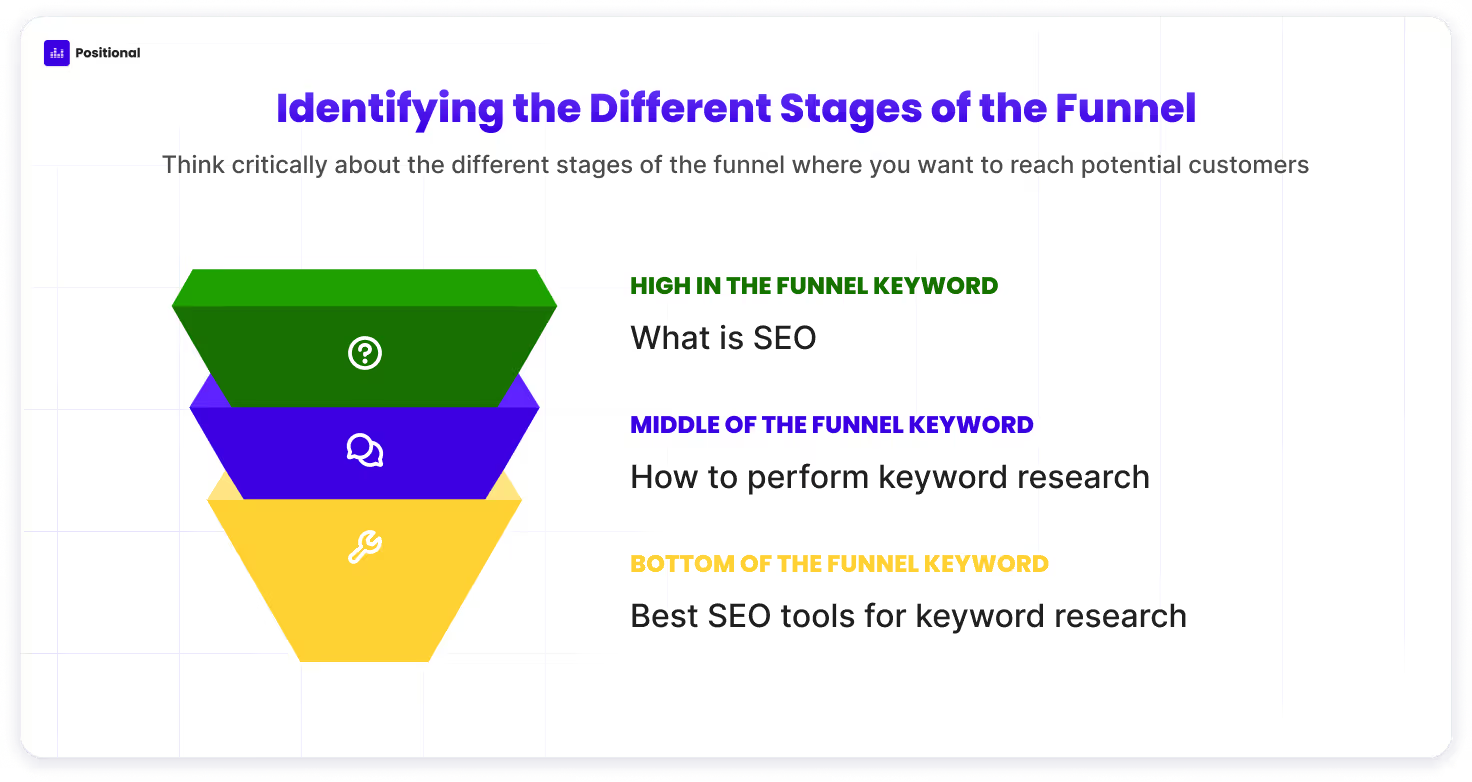
Here are a few examples:
- High-in-the-funnel keyword: What is SEO?
- Middle-of-the funnel keyword: How to perform keyword research
- Bottom of the funnel keyword: Best SEO tools for keyword research
As you’re doing your keyword research, you want to map the keywords and questions to the different stages of the funnel. While it might be tempting to target only the bottom section of the funnel, creating content across the different stages will make sense for most companies. Google’s search algorithms want to understand what your website is about and what it’s a good resource for, and by creating content across the various stages of the funnel, you’ll be giving Google the information it needs.
This concept is often described as building topical authority or topical relevance. In other words, by driving a lot of traffic to more evergreen content on your site, you’ll typically have a positive impact on the performance of your bottom-of-the-funnel pages, too.
You’ll also want to think critically about the different calls to action (CTAs) you use across these stages. CTAs aren’t one-size-fits-all. A more evergreen piece of content might be best served by a CTA for your email newsletter, whereas a down-the-funnel piece of content might be best served with a direct “book a demo” link.
Use Data to Find and Prioritize Keywords
There are a number of different tools you can use to perform keyword research, including those in toolsets like Positional, Ahrefs, and Semrush.
Keyword research tools will provide you with data that you can use to prioritize your keywords. For example, they will give you the number of times a specific keyword is getting searched each month, the difficulty of that keyword, related keywords, and more.
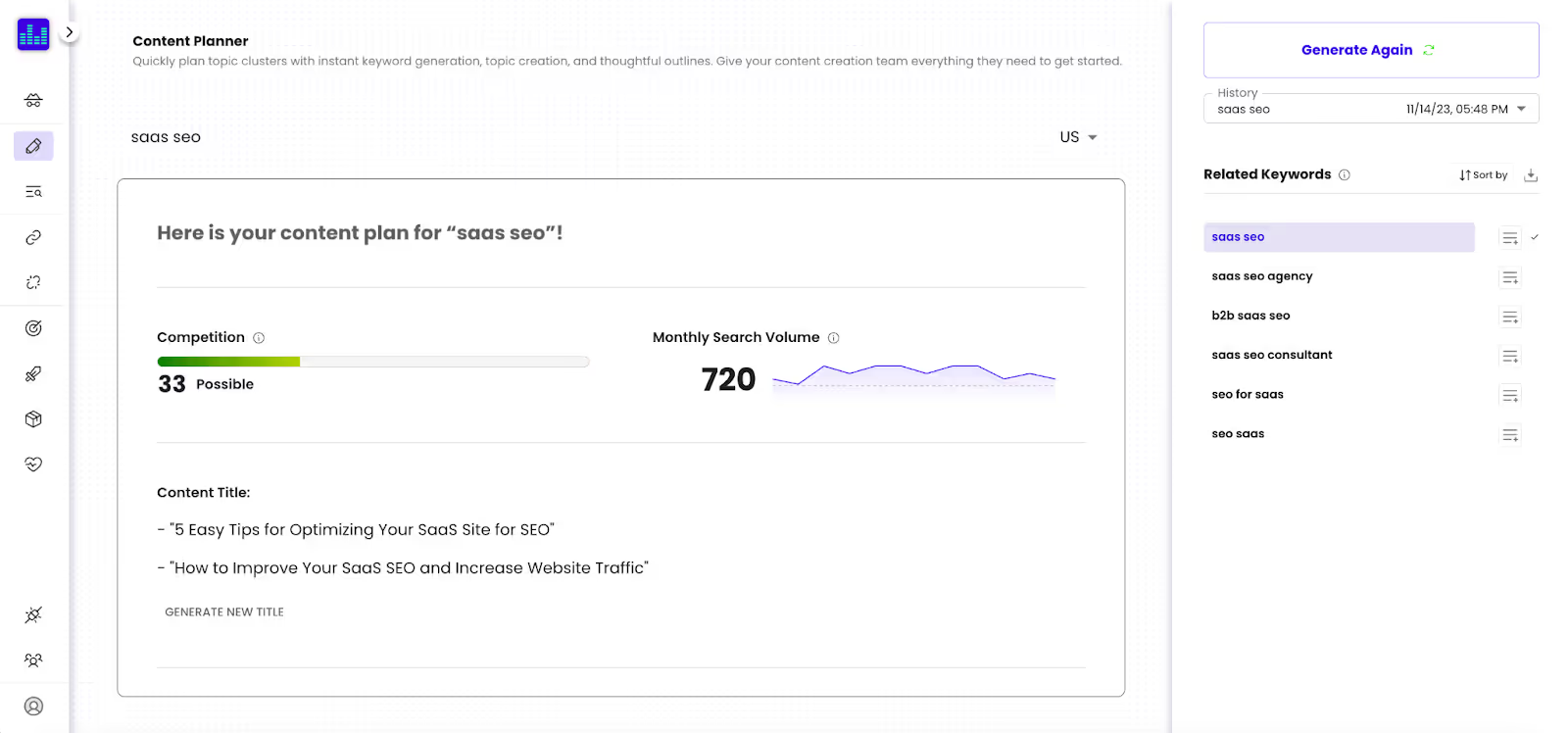
There are typically two different types of keywords: head terms and long-tail keywords.
Head terms are typically broad or more general search queries, like “SEO,” whereas long-tail keywords are more specific search phrases, like “how to optimize a title tag for SEO.” Head terms tend to be more competitive, and the search intent, or the reason someone is searching, is often unknown, whereas long-tail keywords tend to be less competitive, and the search intent is very clear.
Keyword research tools will often provide tools for competitor keyword research, too. Using your competitors as a source for keyword inspiration is a great way to find keywords that you might be missing out on. Keyword research tools will provide you with a list of the keywords your competitors are ranking for and will often provide you with estimates of how much traffic your competitors are driving to those pages from organic search.
It’s great to compare your website against the sites of direct business competitors to find higher-intent or bottom-of-the-funnel keywords quickly. Still, you’ll also want to compare your site against those of more general competitors or companies that are more broadly in your space, as these websites might be ranking for less obvious keywords that are higher in the funnel but that might still be valuable to you.
After you’ve built your list of keywords, you’ll then want to go through a grouping process, combining specific keywords into single pieces of content to create. This process is typically known as keyword clustering.
Step 3: Build the Content Creation Engine
After you’ve built your list of keywords, you need to create the webpages that target them. The first step is to form an editorial calendar.
Forming an Editorial Calendar
Translating your raw list of keywords into a plan of attack happens with the aid of your editorial calendar, which maps the schedule and the process for creating these pages. Editorial calendars come in many shapes and sizes, but for most companies, starting with a simple spreadsheet will work perfectly fine.
In your editorial calendar, you’ll typically outline the different stages of content creation — for example, the ideation stage, the outlining stage, and the in-editing stage. You can also keep track of all of the inputs required to publish your pages — for example, you may need to source a featured image for the top of each blog post.
We recently published an article on how to create an editorial calendar, and in it, we’ve included a template that you can use as an example.
Creating the Content
You can certainly create this content in-house if your team has the bandwidth to do so. For many early-stage SaaS companies, the founders often create the first few pieces of content on the site. However, creating content can take a lot of time, and we all have plenty of things to do each week. That’s why many SaaS companies choose to hire freelance content writers to help them build their portfolio of content.
By using a freelance writing team, you’ll be able to move faster and create more content. Of course, you’ll want to provide these writers with detailed content outlines breaking down what should be included in your content. You may also want to hire a freelance copy editor to proofread and clean the pieces before publishing.
Optimization
You and your freelance writing team could also consider using a toolset for content optimization. At Positional, our Optimize toolset can be used in both the outlining process and the writing process for SEO-optimized content. Some other popular content optimization tools are Clearscope and Surfer SEO. You’ll want to optimize for long-tail keywords or more specific variants of the primary keywords you’re targeting. And you’ll also want to optimize your headers, title tags, permalinks, and more.
Cadence
SaaS startups always ask me how much content they should create or what the right cadence for new content creation is. My general advice is to stick to one new piece of content per week. And if you do that for an entire year, you’re going to have 52 highly targeted pieces of content on your website. You can, of course, move faster than that if you’d like. When we built a SaaS blog recently, scaling it to more than 200k visitors per month in 14 months, we were publishing between three and five pieces of content per week.
Getting into a rhythm and sticking to your editorial calendar is mission-critical. As mentioned, it typically takes 20 to 30 pieces of content for Google to start paying attention to your website. And you’ll often hit different inflection points — say, at three, six, and 12 months — at which traffic starts to scale exponentially faster than new content creation. This happens as Google understands what your website is about and sees a positive signal that searchers are enjoying your pages.
Step 4: Build Backlinks
Backlinks have been and will continue to be an essential component of SEO. A backlink is simply a link from an external website to your website.
When Google first developed its search engine algorithm, it introduced a concept called PageRank, which is a score based on the strength and quality of your website and number of backlinks pointing to your website. You’ll often hear the terms “PageRank” and “domain authority” used interchangeably.
By building additional backlinks to your website, you can show Google that your website is an important source of information. By building backlinks, you’ll increase your domain authority, which will positively impact your search engine rankings and traffic.
There are many different types of backlinks and even more ways to build them. You’ll often hear about guest posting, which is the process of writing a blog post for another site and then including a link back to your site within that post. You can build backlinks with resource pages, through earned press and media, and with data-driven content. As Nathan Gotch described on the Optimize podcast, creating linkable assets or content that a lot of people will want to link to is incredibly important.
But one thing is for certain: You shouldn’t buy backlinks, as that is against Google’s guidelines and can result in your website getting penalized.
Most SaaS companies have already accumulated a number of backlinks organically through a fundraising announcement or from their investors. But even building an additional 10 or 15 highly relevant backlinks to your website can help accelerate channel growth.
Step 5: Ensure Proper Technical SEO
Earlier-stage SaaS companies typically spend too much time worrying about technical SEO. However, for large and established websites, technical SEO becomes very important.
Technical SEO is ensuring that your website is optimized, from a technical point of view, for Google’s crawlers and searchers.
At a minimum, you should ensure that your website has a working sitemap and that you’ve submitted it with Google Search Console (GSC). You also want to make sure that you are internally linking your web pages to each other. Internal linking is arguably the most important technical SEO concept and will help Google understand how all of the pages on your website are interconnected and related. Internal links are also crucial for passing page authority across your website.
We wrote a comprehensive guide to technical SEO, which recaps 15 best practices to remember when building your website.
Step 6: Repurpose Content to Other Channels
As mentioned previously in this article, building an SEO channel takes time. But the good news is that by building out the portfolio of content on your website, you’re also creating a lot of collateral that you can repurpose onto other channels.
For example, if you’ve created a long-form blog post for SEO, there may also be an opportunity to create a LinkedIn carousel or a Twitter thread on the topic, as I’ve done here — repurposing our article on hiring freelance writers:

And if you’ve got an email newsletter, you should share all of this content there, too.
By driving traffic to your website from channels other than organic search, you can actually have a very positive impact on the performance of your pages in search. Off-page traffic from a social channel or from an email newsletter is a confirmed Google ranking factor, according to Backlinko. As just one example, on the Optimize podcast, Aakash Shah reiterated that the positive traffic gains he was seeing on TikTok and YouTube were having a direct impact on the rankings of his pages in organic search.
3 Mistakes SaaS Companies Make With SEO
There is so much to do when it comes to building an organic search channel. Unfortunately, there are quite a few gotchas and common mistakes that SaaS companies will make when doing so.
1. Overly Promotional Content
You should create content that is beneficial for the searcher. And often, that means making content that isn’t overly promotional about your product or service. A mistake that SaaS companies make is creating content that targets a high- or middle-of-the-funnel keyword but approaching that piece as if it were a bottom-of-the-funnel piece of content.
Do what is best for the searcher, and if that means promoting your product within the body of the article, then do it. But try to avoid stuffing too much marketing material into a blog post if it would feel unnatural or unhelpful for the reader.
We’re a SaaS company ourselves, and you’ve seen us mention some of our core products when relevant and helpful within this piece of content. We’ve also mentioned some of our popular competitors.
You can also use CTAs strategically within your blog pages, including in the sidebar, within the body of the article, and at the end of the piece of content. Our Content Analytics toolset can be helpful for positioning your CTAs within the bodies of your pages. Did you like that product plug?
2. Only Focusing on the Bottom of the Funnel
As mentioned previously, you’ll want to create content across the different stages of your funnel. For one thing, it can be helpful for reaching a larger audience of potential buyers earlier in their sales journeys. But it’s also critical for building your website’s topical authority or relevance — in other words, showing Google that your website is an excellent source of information on a particular topic.
A mistake that SaaS companies will make is focusing only on the highest-intent keywords at the bottom of their funnel. As a result, it will often be a lot harder to rank these pages in organic search, and they are likely missing out on quite a bit of valuable traffic in the earlier stages of the funnel.
3. Large Amounts of Low-Quality Content
When you’re just starting out, doing the first two things right — the right keywords and the right content — is where you should be spending most of your time.
Unfortunately, many SaaS companies will pick all the right keywords and then create a large amount of very low-quality content shortly after that.
You should optimize for quality over quantity. If you create large amounts of low-quality content, whether it’s thin content, duplicative content, or AI-generated content, know that ranking your pages in organic search is going to be harder. You’ll likely run into indexing challenges and see messages like “Discovered - currently not indexed” appearing in GSC.
Google has said very mixed things about using AI-generated content. You can certainly use it, according to Google, but you’ll want to use it as a starting point in the content creation process and not as a means to manipulate search results, in their words.
3 Examples of Awesome SaaS SEO Strategies
From the seed stage to Series E, there are many examples of SaaS companies crushing it with SEO. We’ve handpicked three examples.
1. OpenPhone
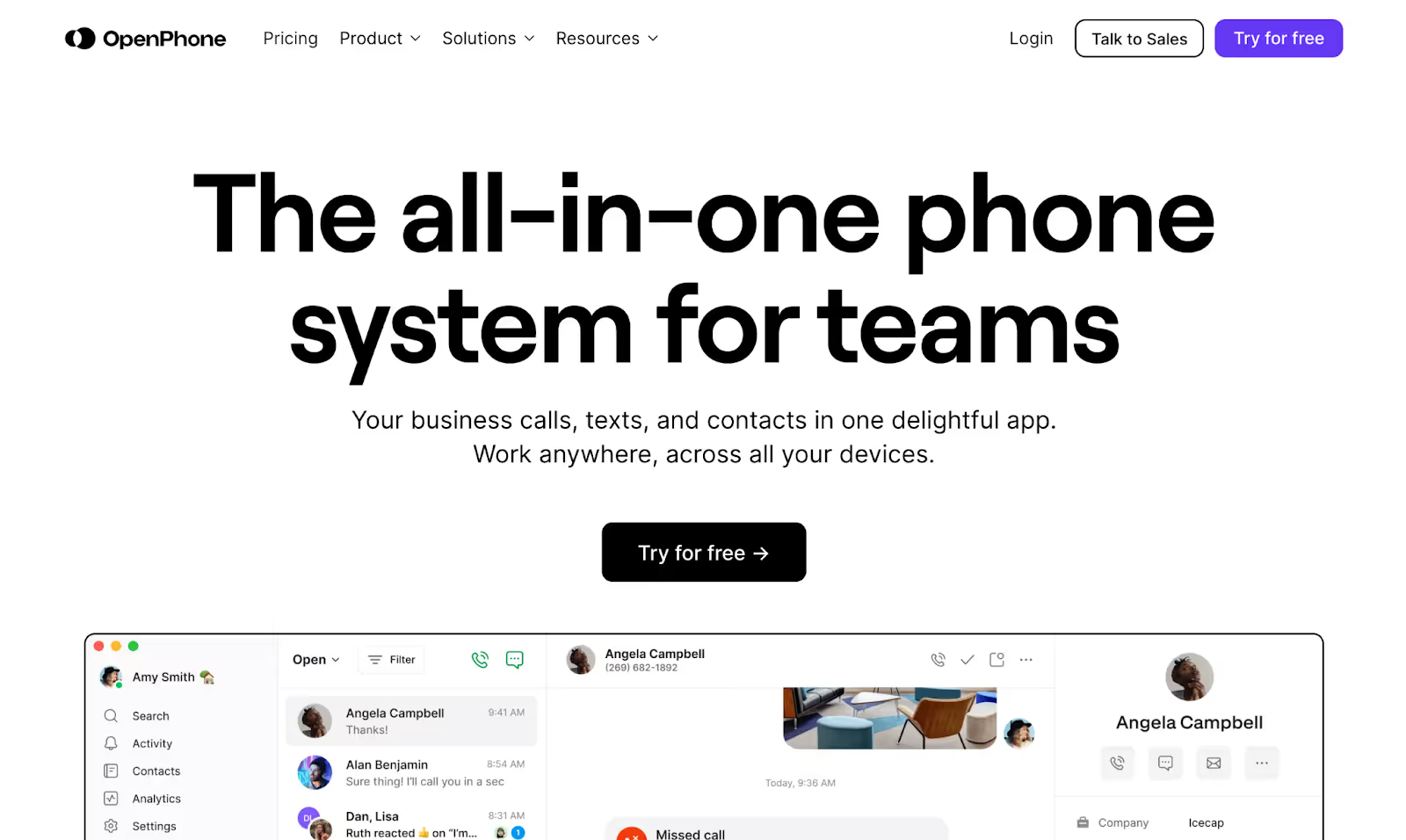
OpenPhone is a provider of SaaS-based tools for managing business calls, texts, and contacts. Today, the company ranks for more than 200,000 keywords and is driving more than three million visitors to its website each month from organic search.
OpenPhone uses both an editorial or traditional SEO strategy and a programmatic SEO strategy. For example, OpenPhone has created a large number of blog pages targeting different buyer journeys. They target very high-intent keywords — for example, “RingCentral alternatives,” with direct comparison pages about their competitors. And they also target middle-of-the-funnel keywords with in-depth tutorials — for example, this tutorial targets keywords like “How to get a US phone number.”
OpenPhone also uses programmatically generated pages to target keywords around specific area codes, for example, “267 phone number.”
We had Ronnie Higgins, the Director of Content at OpenPhone, on the Optimize podcast. Ronnie was kind enough to tell us about his approach to building content marketing and SEO channels and provided some tactical advice for getting started.
2. Canva
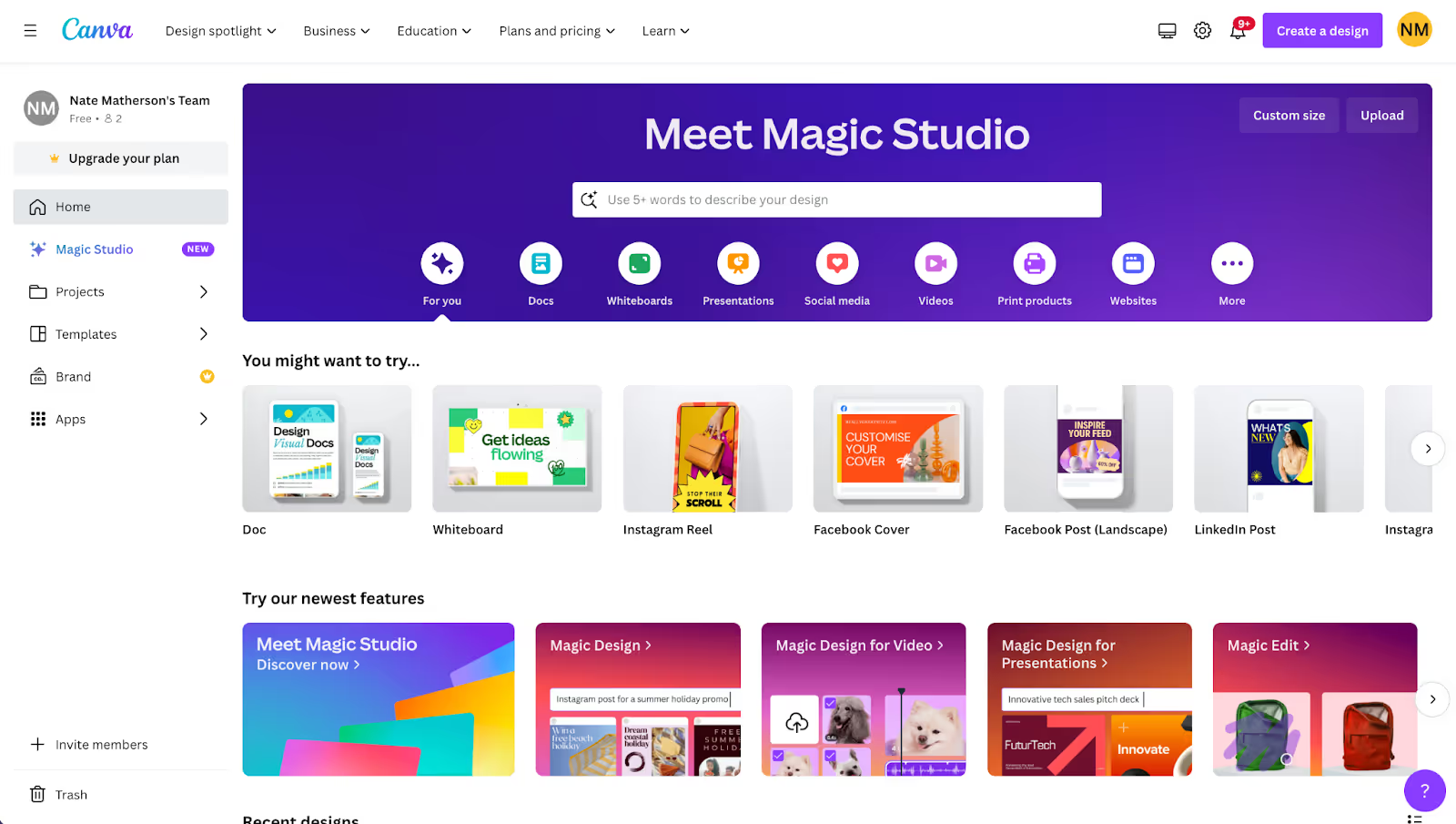
Canva provides a number of tools for graphic and visual creation. SEO has been a core strategy for Canva since the very beginning. Today, the company ranks for more than eight million keywords and is driving more than 120 million visitors to its website each month from organic search.
Canva uses both an editorial content strategy and a product-led SEO strategy that they’ve developed with programmatic SEO.
For example, on their blog, they create pieces of content targeted to specific keywords — for example, this in-depth guide that targets “brand management.” They then use the product-led SEO approach to rank for particular use cases or projects you could complete with Canva — for example, creating a wedding place card template.
3. ClickUp
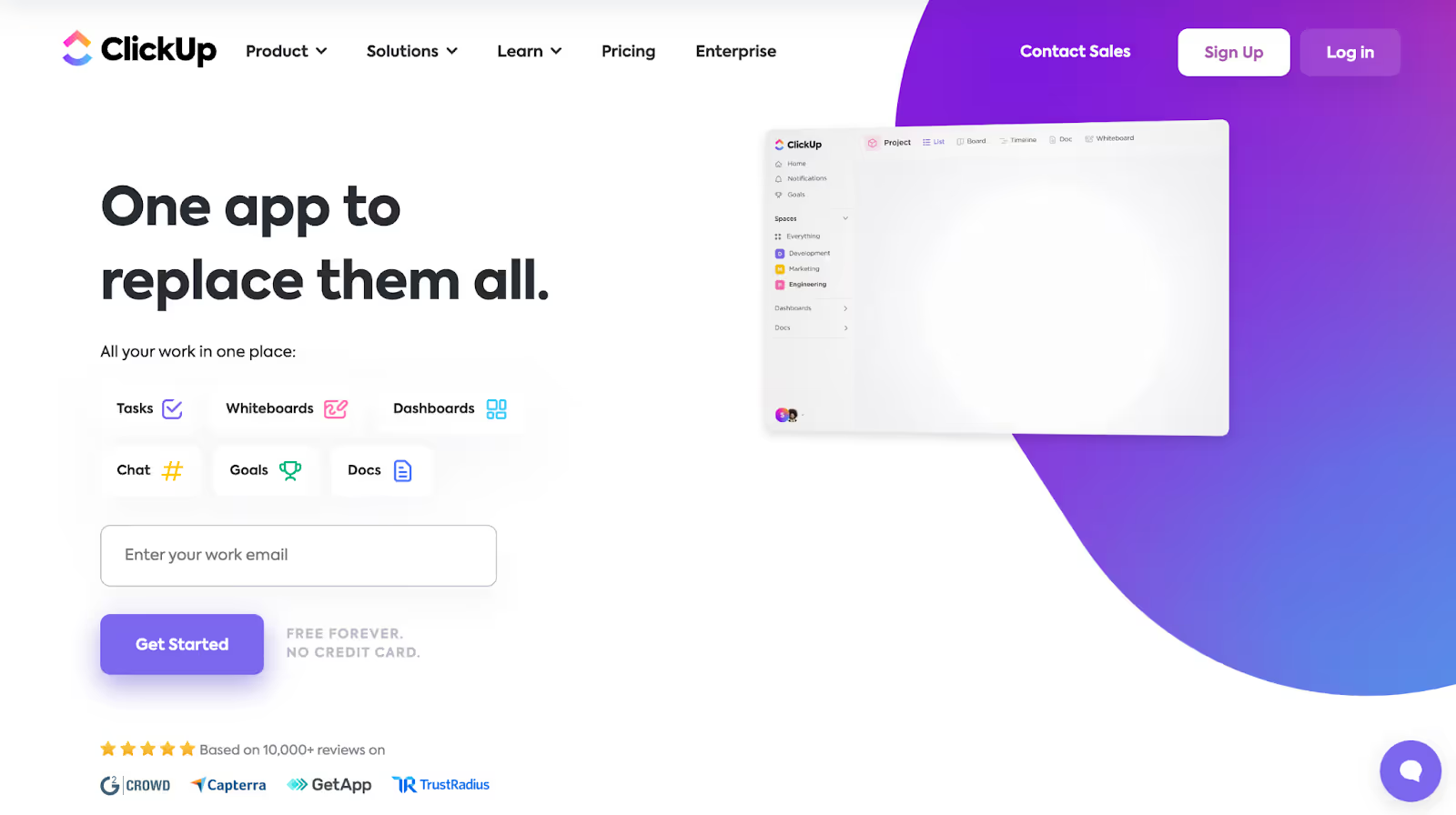
ClickUp is a popular project management and productivity tool. Today, the company ranks for more than 950 thousand keywords and is driving more than two million visitors to their website each month from organic search.
ClickUp has built a robust content engine and is creating a large amount of content on its blog, where the company targets keywords up and down the funnel, ranking for keywords like “task vs. project management” and several high-value down-the-funnel keywords like “best productivity tools,” with listicles and roundups of popular tools to use.
Final Thoughts
For a SaaS company, building a successful content and SEO channel can be very competitive due to the highly valuable customers and recurring revenue that we’re looking to acquire. But that being said, the inputs to building a successful SEO strategy are relatively straightforward.
As we highlighted in this article, you’ll want to start by identifying the right keywords and topics to write about — and that entails thinking critically about the questions that prospective customers ask you. You’ll also want to do competitor research to identify which keywords your competitors are ranking for that you might be missing out on.
From there, you’ll want to create helpful and optimized pages to target those keywords. Along the way, you’ll want to build some backlinks, ensure proper technical SEO, and repurpose the content you’re creating for other distribution channels.
At Positional, we provide many tools for the modern SEO team, including tools for keyword research, content optimization, technical SEO, and content analytics.





